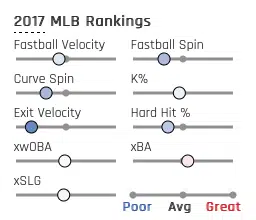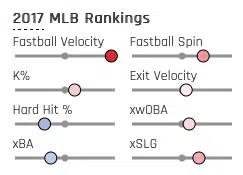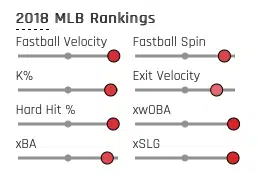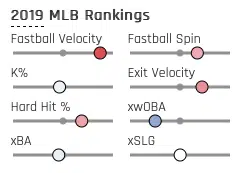This year, a whopping 40 players were non-tendered at the December 1 deadline. For comparison, there were only 27 players non-tendered in 2018, and only 18 the year before. In the ever-changing landscape that is the MLB offseason, the arbitration market was naturally going to be the next area to evolve. With it has come the idea that there is more value on the open market for any given need (the owners are likely right about this one too – none of the non-tendered players posted over 2.0 fWAR last season).
With that being said, the depth of any team looking to compete often makes or breaks their postseason chances. Each member of the now 26-man roster is incredibly important as teams look to make the postseason in 2020 and beyond. The White Sox are one of these teams, and for all the front-line talent coming through the system, there is currently a worrisome lack of depth on this roster.
Enter the 40 new names that just fell into the market. There were some very surprising non-tenders among the bunch – five of which I’ve outlined here as players the White Sox should absolutely keep their eye on.
DISCLAIMER: None of these names are meant to be substitutes for going out and signing/acquiring high-quality talent; rather, these are players that either can help fill out a roster with the sort of depth needed to make a late October push, or are a Plan B option when Plan A doesn’t work.
Blake Treinen
Blake Treinen is just one year removed from being one of the best relievers in baseball. In 2018, he was 9-2 with a minuscule 0.87 ERA (7 ER in 80.1 IP), a 531(!) ERA+, and 100:21 K:BB ratio. There was something underlying the difference in between his two season, as you can see by his Statcast Metrics:
For some reason, Treinen regressed back towards his 2017 self rather than replicating his 2018 self. He did lose some velocity on his pitches in 2019, but that could just as easily come from mechanics as it did from age, especially with how these overall metrics look. Now, there’s plenty of video available, and there’s no doubt any team that signs Treinen will be helping him study his 2018 season and work to build that fastball spin rate back up. Any team that has devoted itself to studying pitch design is going to love the Blake Treinen Project. As a result, he is likely going to be in high demand. I would love for it to be the White Sox who go out and grab him.
Upside: Treinen recaptures his 2018 success with the help of Don Cooper and Co. and helps create one of the best back-end of the bullpen in baseball with Alex Colome and Aaron Bummer.
Risk: Treinen never recaptures his 2018 success and becomes a low leverage situation pitcher.
Cesar Hernandez
Cesar Hernandez was the latest victim of the infield shake up in Philadelphia. He has been incredibly steady throughout his career, appearing in at least 155 games in three of the last four seasons and in 161 games the past two seasons. He’s been an interesting player over the past two seasons, hitting 15 and 14 home runs in 2018 and 2019, respectively, yet with only a 28.3% Hard-Hit % (for comparison, Yolmer Sanchez’s Hard Hit % was 27.1%).
He likely will be going somewhere he can compete for a starting job, but depending on how his market develops, the White Sox should absolutely be taking a flyer on Hernandez to serve as crucial depth – and to start the season as the White Sox 2B until Nick Madrigal comes up a few weeks into the season. There is still plenty of playing time to be had on this team, but the White Sox would have to sell Hernandez on the team’s potential rather than individual playing time. Heading into his age 30 season, he might not buy into that.
Upside: Hernandez becomes the crucial off-the-bench utility player that Yolmer Sanchez struggled to be offensively, while providing average to above average defense.
Risk: Hernandez’s 9th percentile average exit velocity catches up to him, much like it did to Yolmer Sanchez. He becomes Yolmer Sanchez offensively and Discount Yolmer Sanchez defensively.
Domingo Santana
Domingo Santana was non-tendered by the Mariners after a season in which he hit .253/.329/.441 with 21 home runs. He is just a couple years removed from a 2017 season in which he hit .278/.371/.505 with 30 home runs. So, the power potential is there for Santana. However, he doesn’t come without his downside. He has at least a 30% K-Rate in all except one of his career season (2017, when it was ONLY 29.3%), and he is a butcher – to put it nicely – in the outfield. He is in the first percentile for Outs Above Average and the second percentile for Outfielder Jump. These numbers resulted in an ugly -13 Outs Above Average in 2019. Only Eddie Rosario was worse in 2019. Add that to the fact that Eloy Jimenez posted -11 Outs Above Average in 2019, and Luis Robert better be a gazelle in the outfielder if the White Sox were to put these two players in the corners consistently.
Santana posted a 2 Outs Above Average season in 2018, so he has the potential to be capable. However, he should not be the first option for the White Sox in RF heading into 2020. If plans fall through over the next couple of months, Santana could serve as a productive offensive one year option for the South Siders as they look to fill RF long-term. However, he will likely opt for a team where he can be guaranteed consistent playing time, which he no doubt deserves.
Upside: Domingo Santana re-captures his 2018 season in Milwaukee and gives the White Sox quality defense in the outfield, helping the White Sox forget any shortcomings they had while trying to fill RF via other routes in free agency. Or, if all goes well when signing other free agents, he becomes an effective late-inning bat, should he accept more limited playing time.
Risk: He remains a 30% K-rate hitter while also seeing his power diminish and his defense remain ugly. In short, he becomes pretty useless outside of the occasional power supply.
Taijuan Walker
Taijuan Walker was non-tendered by the Diamondbacks. He has not pitched much in the past two seasons due to a torn UCL and a shoulder injury. He pitched in just one game at the end of the season in 2019 and is projected to enter the 2020 season healthy. When healthy, Walker has been a solid back of the rotation starter: from 2015-2017, he started 82 games, posting a 4.10 ERA, 102 ERA+, and 422:138 (3.05:1) K:BB ratio. He will be just 27 years old next season, so he is far from past his prime. His underlying StatCast metrics aren’t overly promising, but these do date back to 2017 before Spin Rate and Effectively Velocity were highly prioritized parts of pitch design.

The White Sox should not rely on Taijuan Walker to be a starter who can go out and throw 180-200 innings. However, they should consider him as pitching depth. However, it is likely the Walker finds himself on a rebuilding team that is willing to give him 180 innings to help rebuild his value to the rest of the league.
Upside: Much like with Treinen, Walker works with Cooper and Co. to regain some of his pre-2018 success as an effective 5th starter. He gives the White Sox plenty of meaningful innings in a season where Michael Kopech, Dylan Cease, and Carlos Rodon will be on some sort of innings limits.
Risk: 2016 Mat Latos. An oft-injured reclamation project that never regains his prior success.
Kevin Gausman
Kevin Gausman was non-tendered by Cincinnati. The 28-year-old right hander split his time between being a starter in Atlanta and a reliever in Cincinnati. Gausman found much more success as a reliever, posting a 4.03/3.17 ERA/FIP and a 114 ERA+ across 15 appearances for the Reds. So, there is some room for improvement as well based on his numbers out of the bullpen.
As he is just entering his age-29 season, Gausman has the potential to provider the Sox with SP depth and middle relief help. He is likely past the point of being an effective starter every fifth day – in fact, he never really was an effective starter back in Baltimore. However, there is no reason he shouldn’t be able to repeat his success out of the bullpen, as Statcast’s expected metrics are in line with his results.
Upside: Gausman repeats his second half success in Cincinnati and gives the White Sox meaningful innings out of the bullpen and the occasional start as injuries/innings limits become factors.
Risk: Gausman flames out and doesn’t provide much help out of the bullpen. He’s definitely a pretty low risk, high reward option.
Honorable Mentions
Travis Shaw (1B/3B), C.J. Cron (1B), Jimmy Nelson (RHP). These three names would provide power potential (Shaw, Cron) or, like Gausman, SP depth (Nelson) to a team that desperately needs both. Nelson and Cron are coming off of injuries that limited their second half production, and Shaw had an absolutely brutal season in Milwaukee. All of these guys would be cheap bounce back options.
None of these players should be considered first-choice options for the White Sox heading into 2020 – all of these players are better served as placeholders rather than daily guys to count on everyday. However, as I mentioned before, the White Sox currently have a worrisome lack of depth. The upside of any of these players provides the White Sox with the depth they would need to effectively sustain the grueling 162-game schedule with the additional restrictions that injuries/innings limits will place on this team.
The big moves only mean so much. For the best teams, it is often these second and third tier moves that mean the most. Remember Howie Kendrick and Asdrubal Cabrera for the Nationals this year? It’s time for Rick Hahn to start to find these sorts of players for the White Sox as he works to build the most complete roster heading into this contention window.
Agree? Disagree? Who else would you consider? Let me know on Twitter! @jlazowski14
Featured Photo: Philadelphia Phillies/Twitter (@Phillies)



